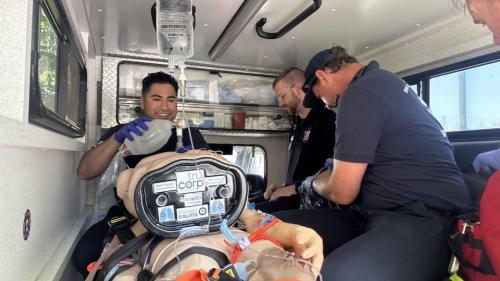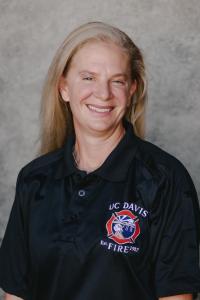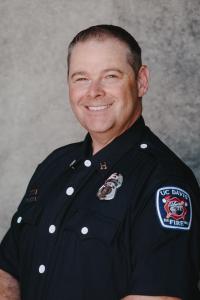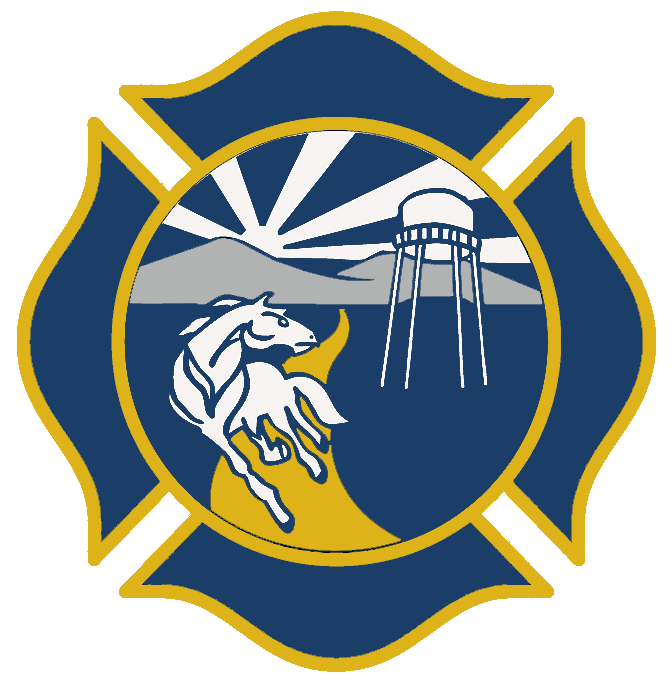Now offering an Accelerated Hybrid Paramedic Program
The UC Davis Fire Department Paramedic Program provides specialized, rigorous training to help cultivate the healthcare heroes of tomorrow.
Table of Contents

Course Description
The UC Davis Fire Department paramedic program is designed to provide students the opportunity to learn up-to-date principles and practices of Advanced Life Support (ALS) pre-hospital emergency care in a didactic (classroom and lab), clinical (in-hospital), and field (on an ambulance) setting. Fast-paced and intense, this hybrid course is designed for the working individual. Upon completion, paramedics will be able to integrate their knowledge of pathophysiology with a patient’s history, vital signs data, and physical findings in order to render the best care possible to sick and injured patients.
This course covers the didactic and psychomotor material necessary to establish a foundation for paramedic prehospital patient assessment and management. Topics include preparatory, human body and human systems, pharmacology, patient assessment, airway management, and emergency care for patients suffering from respiratory, cardiac, shock, traumatic, medical, obstetric, pediatric and neonatal emergencies.
Accelerated Hybrid Paramedic Program (Completion in 1 Year)
The accelerated course is intended for students with prior experience and strong foundational knowledge. Success requires effective study habits, time management, and the ability to learn independently. It is not recommended for beginners or those needing frequent guidance.
- Small class size
- Clinical hours performed at the UC Davis Medical Center (250 hours total)
- Practical anatomy and skills lessons in cadaver lab
- Students receive ACLS, PALS, PHTLS, & AMLS certificates throughout the course
- Skills labs held every other weekend (Saturday and Sunday) to accommodate travel and busy schedules
Standard Hybrid Paramedic Program (Completion in 16 Months)
- Small class size
- Clinical hours performed at the UC Davis Medical Center and Dignity Health (300 hours total)
- Practical anatomy and skills lessons in cadaver lab
- Students receive ACLS, PALS, PHTLS, AMLS, TECC, & ABLS certificates throughout the course
- Skills labs held weekly on Fridays
Course Outcomes* (Both Programs)
- Course Outcomes
- Define the paramedic roles and responsibilities within an EMS system, and how these roles and responsibilities differ from other levels of providers.
- Explain the importance of personal wellness in EMS.
- Define the role that ethics play in decision-making in the out-of-hospital environment.
- Apply the general concepts of pathophysiology for assessment and management of emergency patients.
- Describe the legal issues that impact decisions made in the out of hospital environment.
- Integrate pathophysiological principles of pharmacology and the assessment findings to formulate a field impression and implement a pharmacologic management plan.
- Safely and precisely access the venous circulation and administer medications.
- Integrate the principles of therapeutic communication to effectively communicate with any patient while providing care.
- Establish and/or maintain an open airway, oxygenate, and ventilate a patient by mastering techniques in Bag Valve Mask, Supraglottic Airway and Endotracheal Intubation.
- Use the appropriate techniques to obtain a medical history from a patient.
- Integrate the principles of history taking and techniques of a physical exam to perform a patient assessment.
- Apply a process of clinical decision making to use the assessment findings to help form a field impression.
- Follow an accepted format for dissemination of patient information in verbal form.
- Effectively document the essential elements of patient assessment, care, and transport.
- Describe the knowledge and principles associated with the acute management of respiratory emergencies.
- Demonstrate the appropriate management of a patient suffering from a respiratory emergency.
- Describe the knowledge and principles associated with the acute management of cardiovascular emergencies including acute coronary syndrome and cardiac arrest.
- Demonstrate the appropriate management of a patient suffering from a cardiovascular emergency.
- Demonstrate the skills and ability to treat and manage an adult patient with acute coronary syndrome, or in cardiac arrest.
- Describe the knowledge and principles associated with the acute management of traumatic emergencies.
- Demonstrate the appropriate management of a trauma patient with complications affecting airway, breathing, circulation, hemorrhage, and shock.
*Outcomes are prescribed by the U.S. Department of Transportation National EMS Education Standards, National EMS Scope of Practice (SOP) Model and California Title 22, including the appropriate SOP transition material found at EMS.gov.
Tuition, Fees and Other Costs
Students should expect to pay approximately $16,900 to complete the paramedic program. After completion of the program students should expect to spend an additional $865 to become licensed as a paramedic in the state of California. The expected costs are outlined as follows.
Application Fee
A non-refundable application fee of $125 is due upon submission of the application. This cost includes the fee to take the entrance exam and BLS skills testing.
Tuition
Tuition for the Paramedic Program is $13,000 and includes 300 hours of clinical experience in the UC Davis Medical Center and the following certifications:
- AHA Advanced Cardiac Life Support (ACLS)
- AHA Pediatric Advanced Life Support (PALS)
- NAEMT Prehospital Trauma Life Support (PHTLS)
- NAEMT Tactical Emergency Medical Care (TECC)
- NAEMT Advanced Medical Life Support (AMLS)
Required Materials and Accounts Purchased by the Student
- The following items are required and purchased directly by the student. The approximate total cost is $1,965.53.
- Paramedic Jones & Bartlett Learning Flipped Classroom Package – $769.78
- ACLS, PALS, PHTLS, AMLS, TECC – $407
- Additional textbooks and task books – $46
- Platinum EMS Testing – $105
- EMCE Pro Paramedic – $100
- Class uniforms (3 polos, 3 short-sleeve shirts, 3 long-sleeve shirts, 1 crewneck sweatshirt) – approx. $291
- Stethoscope – approx. $100 (for a high-quality stethoscope)
- Background check, drug screen, and immunization tracking – approx. $100 (students must use designated providers)
- Liability insurance – $25
- 5.11 Navy-blue EMS cargo pants – $65
- Black basket weave leather belt – $45
- Black polishable EMS boots – approx. $120
- Immunizations as required – cost varies by student
Please note that costs may change as these items are purchased through third-party vendors.
Field Internship Fees
Requirements
To be admitted into the paramedic program all students must meet all pre-requirements, submit a paramedic program application with a resume and cover letter, verify work experience, receive a passing score on the Fisdap Paramedic Entrance Exam, pass an EMT/BLS skills exam, and successfully pass a screening interview. Applicants who successfully pass all phases/steps will be ranked by the scores received. Applicants receiving the highest scores will be selected for admittance into the program.
- Background check and Drug Screening
Students must successfully pass an approved background and drug/alcohol screening as well as complete immunization tracking prior to the scheduled deadline. If you fail to complete the requirements by the due date provided in class, you will not be able to complete your clinical experience requirements and will not pass the class. It is important to note that EMS employers may have more stringent background requirements. Faculty are neither qualified nor authorized to advise students regarding legal issues. Contact the Counseling Center regarding criminal record expungement.
The drug screening is a 10-panel urine analysis that test for the following substances:
- Amphetamines
- Barbiturates
- Benzodiazepines
- Cocaine
- Marijuana
- Methadone
- Methaqualone
- Opiates
- Phencyclidine
- Propoxyphene
Students must screen negative for all substances, including marijuana (THC). All non-negative tests will be evaluated by an
independent Medical Review Officer (MRO) provided by the drug screening company. Students who, after review by the MRO, are found to be non-compliant will not be allowed to attend the clinical experience and will not pass the class. Please note, the use of marijuana for medicinal purposes with or without a prescription/medical marijuana card does not waive the requirements and students must still screen negative for THC.
Detailed List of Pre-requisites
Required Accounts and Materials
Application
Accelerated Paramedic Cohort
- Applications Open: May 4–18, 2026
- Skill Test: June 7, 2026
- Zoom Interviews: June 15–19
- Program Acceptance: By end of July
- Mandatory Orientation: August 28
- Class Start Date: September 21
Standard Paramedic Cohort
- Applications Open: July 20–August 7, 2026
- Skill Test: August 28, 2026
- Zoom Interviews: September 7–11, 2026
- Program Acceptance: By end of September
- Mandatory Orientation: December 11, 2026
- Class Start Date: January 4, 2027
or
- Accreditation Status/ Registry Info
The University of California, Davis Fire Department Paramedic program has been issued a Letter of Review by the Committee on Accreditation of Educational Programs for the Emergency Medical Services Professions (CoAEMSP). This letter is NOT a CAAHEP accreditation status, it is a status signifying that a program seeking initial accreditation has demonstrated sufficient compliance with the accreditation standards through the Letter of Review Self Study Report (LSSR) and other documentation. Letter of Review is recognized by the National Registry of Emergency Medical Technicians (NREMT) for eligibility to take the NREMT's Paramedic credentialing examination(s). However, it is NOT a guarantee of eventual accreditation.
The course meets all of the National EMS Education Standards for Paramedics and complies with Title 22, Division 9, Chapter 4 of the California State Code of regulations.
A course completion certificate is awarded to students who pass the course with a score of 80% or better, fulfill all clinical requirements, and successfully complete the capstone filed internship. Successful completion of the Paramedic Program provides eligibility to the National Registry of EMT's Paramedic examination to receive certification as a Nationally Registered Paramedic.
Meet Your Instructors

Program Director and Lead Faculty

Medical Director

EMS Captain and Program Manager
